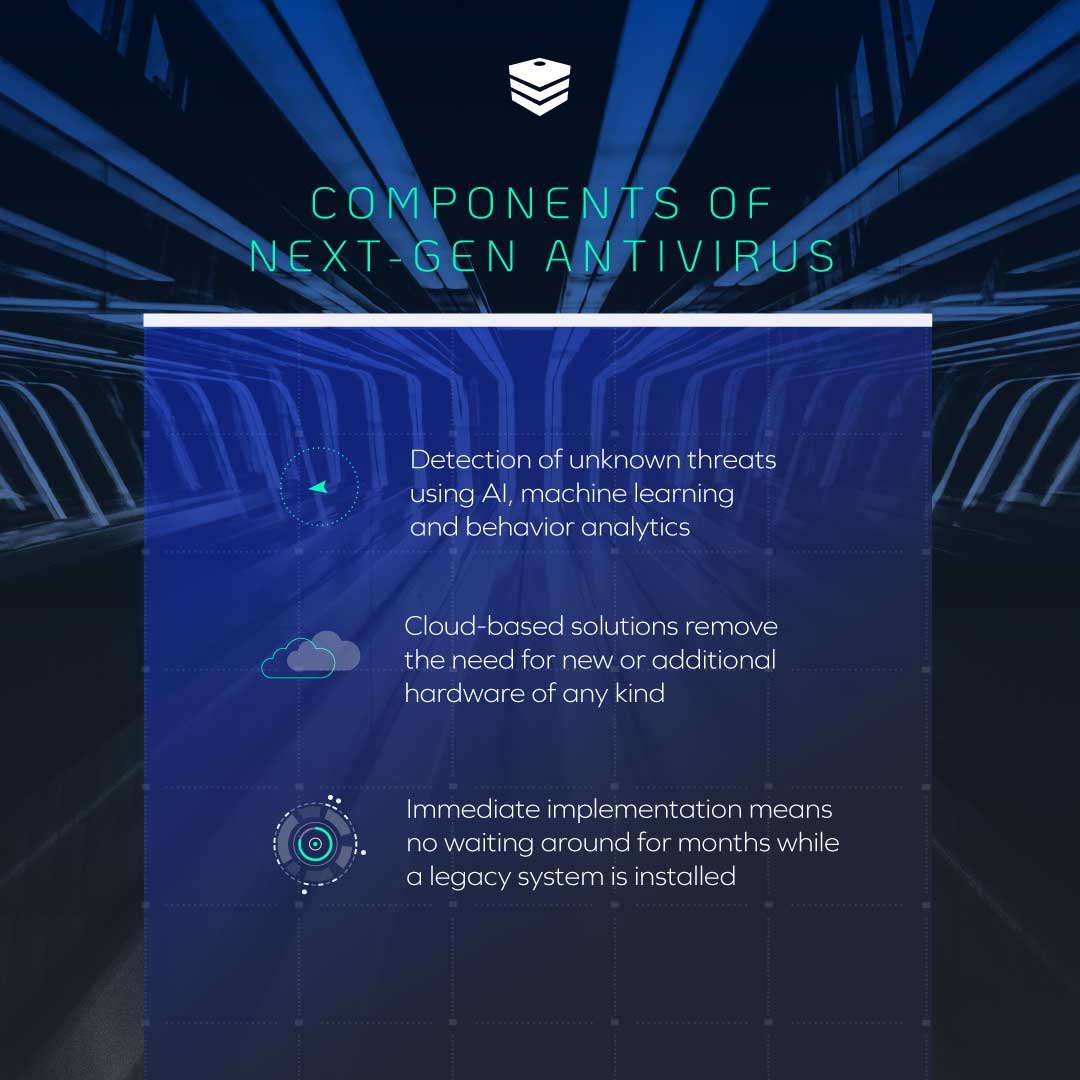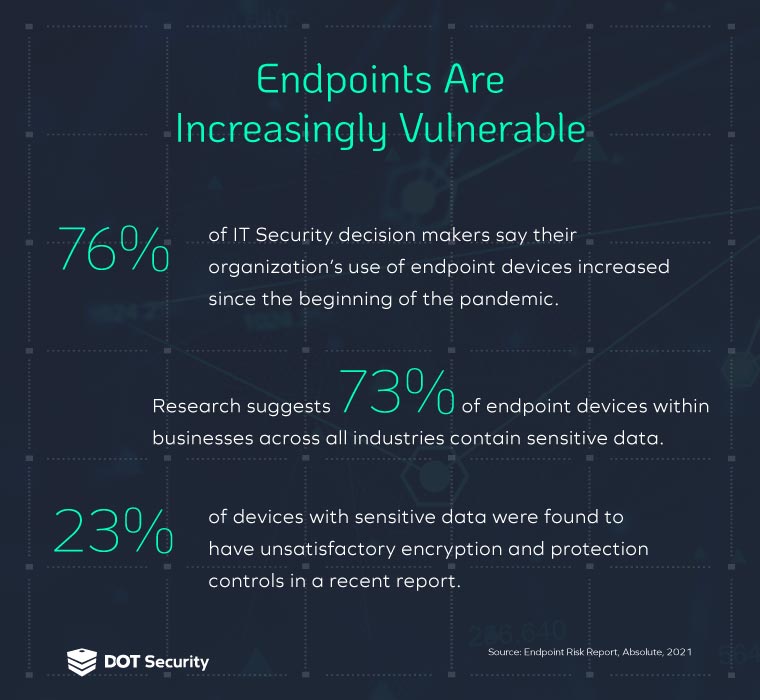Edge Security
The Difference Between Edge Security and Endpoint Protection
September 01, 2022
6 Minutes

Cybersecurity experts currently advise businesses to develop an edge security solutions plan. While edge and endpoint security can be misunderstood, securing both these layers will minimize the effects of a breach.
Read on to find out how edge security and endpoint protection differ and how protecting these devices can help your business continue operations uninterrupted.
Sign up for our newsletter!
What is edge security?
With the global number of Internet-of-Things (IoT) devices increasing, IT and cybersecurity need a way to categorize, organize, and protect different parts of a network.
Edge computing refers to data processing that is done at the “edge” of a network, the farthest point from a centralized data center or cloud resources.
For example, think of a temperature sensor at a manufacturing facility. Before the onset of the internet, these sensors had to be checked and measured manually.
Now, these sensors measure temperatures, store the data, and are able to process this data so that machine monitoring could be done from a remote location.
Since the sensor processes data and sends this data back to a database or cloud in the network, this is an edge device.
Edge security is the practice of protecting these devices and the data they process. Since these devices are at the “edge” of the network, edge security cannot be centralized. There are different types of technology and protocols designed to protect devices in the “edge.”
What are edge security solutions?
Because of the nature of their connectivity and the common lack of updates by manufacturers, edge devices pose a risk to businesses. Experienced hackers can break into the devices to remotely control them, steal sensitive data, or stop operations.
Therefore, different technologies and practices are developed to protect sensitive data and devices. These include:
Firewalls
Firewalls act as gates that filter data passing between your network and the internet. A firewall can filter incoming and ongoing traffic, making sure no malware or unwanted data enters your system.
Scanning outgoing traffic means it can detect malicious acts from inside a network too, such as an edge device that has been compromised.
Next-gen antivirus
Next-gen antivirus software uses machine learning and artificial intelligence to effectively identify and eliminate threats.
Where a traditional antivirus solution detects viruses and malware previously programmed into the software, next-gen antivirus focuses on behavior algorithms that examine processes, data, application use, network activity, and user behavior to help spot unusual activity.

Unified Threat Management (UTM)
A flexible centralized solution that combines multiple security tools into a customized unit. Depending on the size of a business and its industry, multiple technologies are needed.
UTM takes advantage of different technologies and can be managed through a single console or by a single team.
Related Blog: Unified Threat Management (UTM): A Practical Security Toolkit
Specialized Persistence Detection
If a bad actor where to find their way into your business network and remain there for an indefinite amount of time in order to expand and exploit as many vulnerabilities as possible, the best solution is also a human detector.
Human threat hunters can detect anomalies that a computer might not. For example, if hackers disguise a malicious file to look like an accepted file, a device could let the file travel through the network undetected. To the human eye, this file would look conspicuous.
Specialized persistence detection uses cybersecurity experts who continuously monitor a network, searching for bad actors who might have established a foothold.
Related Blog: How to Prevent Advanced Persistent Threats with Specialized Detection
What is Endpoint Protection?
Where edge security protects all the different devices at the “edge” of a network, endpoint protection is the practice of protecting each individual device in a network.
For instance, if a business’s employees have an assigned laptop or if they work remotely with their own device, endpoint protection solutions protect the integrity of those devices and the sensitive data they handle.
Since 70% of businesses reported an increase in phishing attacks since the beginning of the pandemic and with the rise of remote work, businesses should consider implementing endpoint protection on their network devices.
Even if a device belongs to an employee rather than a business, the device can be used to enter the business network, therefore, endpoint protection helps safeguard a business’s data and longevity.

What are Endpoint Protection Tools?
The above technologies, such as firewalls and next-gen antivirus can also provide endpoint protection.
To protect your business’s endpoints, we also recommend taking advantage of the following tools:
Remote Monitoring and Management (RMM)
RMM is technology that allows a cybersecurity team to monitor devices remotely. This is a great alternative when remote workers use their own devices since the lack of protection can increase risks to a company network.
With an RMM solution installed on devices such as computers, mobile phones, or tablets, a security team can:
- Track device information
- Upgrade device software
- Monitor for problems remotely
Identity & Access Management
Allows you to easily manage your network’s authorized users and their level of access to different levels of data. If every employee has access to all kinds of data, any device could pose a security risk.
Related Blog: 5 Identity and Access Management Best Practices
If a breach were to happen, identity and access management lets your cybersecurity team pinpoint who, where, why, and how the network might’ve been breached.
Bottom Line
The Difference Between Edge Security and Endpoint Protection is that edge security aims to protect Internet of Things devices that store and process data. Examples of edge devices are temperature sensors that can send processed data to the cloud or a wearable fitness device.
Endpoint protection on the other hand aims to safeguard user devices such as laptops and mobile phones which could be infiltrated and become a gateway to a network breach.
There are a number of technologies within edge security and endpoint protection that cover all of the layers these devices inhabit and interact with. Since current business networks are formed by many devices in different locations connected in myriad of ways, these technologies help protect a business’s sensitive data.
Depending on the industry and size of your business, it will need a different technology packet. A reliable cybersecurity provider can assess your company network and provide you with a tailored solution.
The rise of remote work has also increased the necessity of a cybersecurity program for businesses. To read about easy, actionable steps to keep your remote endpoints secure, check out Cybersecurity Checklist for When You’re on the Go
